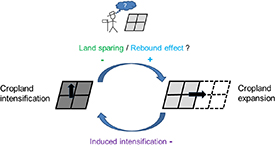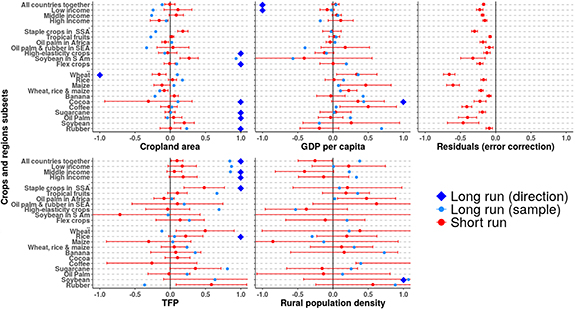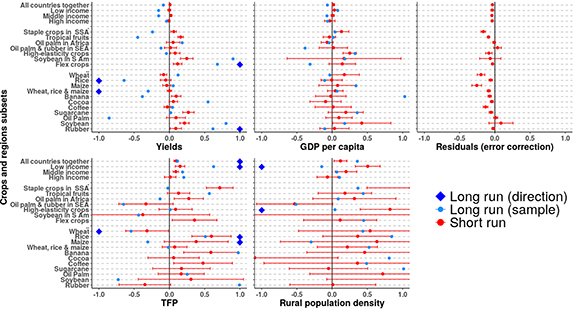Abstract
In the context of growing societal demands for land-based products, crop production can be increased through expanding cropland or intensifying production on cultivated land. Intensification can allow sparing land for nature, but it can also drive further expansion of cropland, i.e. a rebound effect. Conversely, constraints on cropland expansion may induce intensification. We tested these hypotheses by investigating the bidirectional relationships between changes in cropland area and intensity, using a global cross-country panel dataset over 55 years, from 1961 to 2016. We used a cointegration approach with additional tests to disentangle long- and short-run causal relations between variables, and total factor productivity and yields as two measures of intensification. Over the long run we found support for the induced intensification thesis for low-income countries. In the short run, intensification resulted in a rebound effect in middle-income countries, which include many key agricultural producers strongly competitive in global agricultural commodity markets. This rebound effect manifested for commodities with high price-elasticity of demand, including rubber, flex crops (sugarcane, oil palm and soybean), and tropical fruits. Over the long run, strong rebound effects remained for key commodities such as flex crops and rubber. The intensification of staple cereals such as wheat and rice resulted in significant land sparing. Intensification in low-income countries, driven by increases in total factor productivity, was associated with a stronger rebound effect than yields increases. Agglomeration economies may drive yield increases for key tropical commodity crops. Our study design enables the analysis of other complex long- and short-run causal dynamics in land and social-ecological systems.
Export citation and abstract BibTeX RIS

Original content from this work may be used under the terms of the Creative Commons Attribution 3.0 license. Any further distribution of this work must maintain attribution to the author(s) and the title of the work, journal citation and DOI.
1. Introduction
As populations grow in size and affluence, their demands for land-based products and services increase. Crop production can be augmented by allocating more land to crop production (cropland expansion) or by producing more crops per unit of cropland (cropland intensification) (Thomson et al 2019, Meyfroidt et al 2018, Yao et al 2018). Both options create socio-environmental tradeoffs, including the loss of grassland and forest (Curtis et al 2018, Spawn et al 2019). Agricultural intensification, through increases in land productivity—i.e. crop yields—or in total factor productivity (TFP) (Coomes et al 2019), may reduce pressure on land through the so-called Borlaug hypothesis of land sparing. This hypothesis postulates that intensification, by fulfilling a given demand for land-based products with a smaller land base, releases land for other uses including nature preservation (Meyfroidt et al 2018). Modeling studies suggested that the intensification of staple crops globally during the Green Revolution from 1965 to 2004 resulted in relative land sparing—i.e. reducing per-capita land demand or the rate of agricultural expansion compared to the counterfactual scenario without intensification (Stevenson et al 2013).
However, the relationship between agricultural intensification, demand for agricultural products and land use is complex. An alternative hypothesis builds on the 'Jevon's paradox' or 'rebound effect' (Alcott 2005). The paradox occurs if an increase in the productivity of one factor (here cropland) leads to its increased utilization, in a form of spillover where adoption of intensifying practices increases agricultural profitability and stimulates land-use expansion (Angelsen and Kaimowitz 1999; Lambin and Meyfroidt 2011, Hertel 2012, Byerlee et al 2014, Meyfroidt et al 2018).
Three main factors have been hypothesized to condition whether agricultural intensification in one country may lead to land sparing or a rebound effect domestically (Rudel et al 2009, Lambin and Meyfroidt 2011, Byerlee et al 2014, Hertel et al 2014, Villoria et al 2014, Meyfroidt et al 2018): (i) land-supply elasticity, (ii) price elasticity of demand of agricultural products and (iii) competitiveness of the intensifying region. First, land-supply elasticity refers to biophysical, technical (e.g. lack of accessibility in some regions) or institutional (land-use policies, tenure or access rules) constraints on cropland expansion, which are expected to promote land sparing. Weak constraints would support a rebound effect. Over 1970–2005, paired increases in yields and declines in cropland for ten major crops were mostly observed in countries with strong land use policies (Rudel et al 2009). Second, a rebound effect is more likely when intensification results from a technological change shifting the supply curve, and the demand is elastic to prices. This is more likely for products such as meat, luxury or leisure crops (e.g. cocoa, coffee), feed or bioenergy crops, or when markets are well integrated and the intensifying region is large enough to influence prices. With inelastic demand to prices, which is particularly the case for staple crops and when markets are closed, price-reducing intensification will trigger less reactions on the demand and may result in land sparing. Statistical approaches have found evidence supporting this hypothesis for staple crops in developing countries, but non-staple crops have expanded onto lands spared due to the intensification of staple crops (Ewers et al 2009). Third, when intensification increases the ability and performance of a set of producers to sell a product in a given market compared to competitors—i.e. competitiveness—, a local rebound effect is likely either because consumers substitute other products by the more competitive one, or because the region gains market shares against competitors abroad. In the latter case, increased competitiveness may spare land in other regions especially if the product demand is inelastic (Villoria 2019a, 2019b).
Conversely, changes in cropland area are also expected to influence intensification. Induced intensification theories, building on (Boserup's 1965) insights, suggest that intensification arises as a response to growing demand—due to increases in population density, local consumption patterns, and connections with distant markets—along with scarcity of productive and accessible land for agricultural expansion (Turner and Ali 1996). This demand is moderated and mediated by availability of technologies and institutional constraints on land-use expansion among others. Over the long term, technological innovation can endogenously respond to changing scarcity of production factors, as agents invest in innovations that enhance labor or land productivity, determined by the scarcity of either (Ruttan and Hayami 1984, Ruttan 1997). Theoretically, induced intensification is compatible with both land sparing and rebound effect, although in practice, intensification induced by land scarcity and population pressure is unlikely to cause a strong rebound effect.
Our objective is to test the three hypotheses of land sparing, rebound effect and induced intensification by exploring the empirical relationships between changes in cropland intensity and extent, at country scale (figure 1). We assess: (i) What are the effects of changes in cropland area on agricultural intensification, measured through yields and total factor productivity? and (ii) What are the effects of change in cropland intensity on the expansion and contraction of cropland area?
Figure 1. Mutual causation between changes in cropland area and intensity, as hypothesized by the theories of induced intensification, land sparing and rebound effect.
Download figure:
Standard image High-resolution imageWe used an econometric approach with a dataset covering 161 countries over the 1961–2016 period—i.e. a panel—, with data on cropland area and productivity, and key control variables (table S1 (available online at stacks.iop.org/ERL/15/085007/mmedia)). Previous works have explored these questions using general and partial equilibrium models to simulate episodes of agricultural intensification and their effects on cropland (Stevenson et al 2013, Hertel et al 2014). Others works used econometric analysis of country-level panels (Ewers et al 2009, Rudel et al 2009, Ceddia et al 2013, 2014). Here we make progress towards addressing methodological issues in this literature: (i) The use of yield growth as a single measure of intensification, (ii) endogeneity between technological change, factor substitution and land use on the long run, possibly related to simultaneity bias, and (iii) corroborating casual inference via causality tests (Byerlee et al 2014, Villoria et al 2014). Recent efforts explored the role of TFP and used instrumental variables and ordinary least squares (OLS) to explore the potential effects of simultaneity bias and other sources of endogeneity between TFP and cropland area changes (Villoria 2019a, 2019b).
Our study addresses previous methodological issues by using (i) TFP—i.e. the efficiency of the overall mix of production factors (land, labor, and capital) due to improved technologies, farmer's skills, and knowledge (Coelli and Rao 2005, Fuglie 2015, Coomes et al 2019)—along with yield, as two distinct measures of intensification, (ii) lagged variables and first difference estimators to address possible endogeneity, (iii) cointegration to disentangle long- and short-run relationships and identify correlations due to third variables—i.e. spurious relations (Granger 1981), and (iv) an approach designed by (Canning and Pedroni 2008) to test for the direction of the causal effects in our long-run estimated coefficients. This allowed obtaining unbiased short-run effects and exploring the long-run equilibrium and relationships between these variables. Our national-level focus allows exploring the broad patterns across different regions and different types of crops, using long-term data on units large enough to internalize some of the spillover effects.
2. Materials and methods
2.1. Data and variables
We assembled an unbalanced panel dataset of country-level variables covering the 1961–2016 period (table S1). Our key variables were retrieved from the FAOSTAT database. This remains the only long-term, cross-country dataset for exploring our research questions, although it has limitations. Although subnational data is not available, FAOSTAT's national-level data provides some insight into the institutional and technological nuances within and between countries. Crop-specific analyses rely on harvested areas, thereby accounting increasing harvest frequency as area expansion, which may have blurred the results for some crops (Portmann et al 2010), and not adequately capturing intensification through shortening of fallows. Planted area data, which are unavailable in FAOSTAT, would allow avoiding the counting for failed harvest, but would still have other issues including multi-cropping.
We excluded very small countries and those with very little cropland or potential for cropland expansion (supplementary information text). We assumed cross-section independence in each group, and parameter homogeneity. We expressed all variables in natural logarithm to interpret the results as percentage change and elasticities, except for TFP which is constructed as a growth rate and directly interpreted as percentage change, and the annual average temperature and rainfall. We first performed the analyses for all crops together, separating the countries in three income groups (SI text, tables S7, S9, S11, S13). We then extracted subpanels covering specific crops for the main producing countries for these crops (tables S2, S3), selected based on the global importance of these crops and the relation with our hypotheses (SI text, tables S7–S14).
2.2. Hypotheses tested
We tested the following hypotheses (table 1):
Table 1. Hypotheses tested.
| Expected conditions for | |||||
|---|---|---|---|---|---|
| Dependent | Independent | which the hypotheses | |||
| Hypotheses | variable | variable | Sign | should hold | Selected crops and regions |
| 1 | Yield | Cropland | Negative | Staple crops | Wheat, rice, maize, staple crops in Sub-Saharan Africa |
| Rural population density | Positive | Staple crops, labor-intensive crops | The same as above, plus cocoa, coffee, banana, tropical fruits | ||
| 2, 3 | Cropland area | TFP | Positive | Countries with low competitive advantage, for crops that they import. Countries with land available for cropland expansion. Crops with high price elasticity of demand. | Banana, cocoa, coffee, sugarcane, oil palm, rubber (overall and in Southeast Asia), soybean (overall and in South America), tropical fruits in tropical countries, flex crops, high-elasticity crops |
| Negative | Staple crops, crops with low price elasticity of demand. Countries with physical or institutional restrictions on cropland expansion. | Wheat, rice, maize, staple crops in Sub-Saharan Africa | |||
| Yield | Negative | Staple crops, crops with low price elasticity of demand. Countries with physical or institutional restrictions on cropland expansion. | Wheat, rice, maize, staple crops in Sub-Saharan Africa | ||
| Positive | Countries with low competitive advantage, for crops that they import. Countries with high competitive advantage, for crops that they export. Countries with land available for cropland expansion. Crops with high price elasticity of demand. | Banana, cocoa, coffee, sugarcane, oil palm, rubber (overall and in Southeast Asia), soybean (overall and in South America), tropical fruits in tropical countries, flex crops, high-elasticity crops |
Hypothesis 1: Following the induced intensification theory, cropland intensity will increase if local pressure on land increases, here represented by an increasing rural population density or lower rates of cropland expansion. We do not explicitly account for changes in demand from distant consumers. As we focus on the land-use impacts of intensification, here we used only yields as the dependent variable representing intensification, not TFP.
Hypothesis 2: With intensification, staple crops with low price-elasticity of demand will exhibit land sparing. In contrast, intensification of flex crops—crops that can be used for multiple purposes including food, feed and fuel, such as oilseeds—and leisure crops, such as coffee and cocoa, is more likely to result in a rebound effect as these crops have higher price-elasticity of demand.
Hypothesis 3: Intensification occurring through increase in TFP, which directly influences competitiveness, is more likely to result in a rebound effect compared to intensification resulting from increasing yield, which has an ambiguous relationship with competitiveness.
Land sparing and rebound effects can occur within the region that experiences intensification or remotely (Meyfroidt et al 2018). Here we focus on country-level intensification and potential land sparing and rebound effect within the intensifying country, rather than assessing potential spillovers in other countries. In the energy domain, rebound effects include any net decrease in or dampening of the reduction in overall resource consumption stemming from efficiency gain. In land use, the debate around rebound effect has focused on the most extreme form of rebound effect (>100% of rebound effect), called 'backfire', when resource consumption actually increases with efficiency improvements (Hertwich 2005, Sorrell 2007). In our analyses, a positive effect of intensification on cropland area indicates such a backfire effect. A negative effect indicates that, on net, intensification is land sparing, but low absolute values indicate a partial rebound effect, compared to a coefficient with larger absolute value.
2.3. Time series properties of the data
Many time series and panel techniques assume that the series under investigation are stationary. However, time series analyses are often affected by the problem of spurious regression (Granger and Newbold 2001, Wooldridge 2009). This problem can appear when the distribution (average and standard deviation) of the dependent variable and at least one independent variable change over time—i.e. they are non-stationary. This corresponds to time series that are integrated of order 1, I(1), or higher (Wooldridge 2009). Relations observed among non-stationary variables with ordinary least squares (OLS) regressions may not reflect a causal relationship but be actually caused by a third variable, possibly time—known as 'spurious' relation (Baltagi 2005, Wooldridge 2009). The notion of cointegration was developed to address the spurious regression problem and make unbiased conclusions on the short- and long-run dynamics (Granger 1981). If two time series are non-stationary individually but there exists a linear combination of them which is stationary, those variables are cointegrated (Engle and Granger 1987). Such a cointegration regression is not spurious and describes the long-run equilibrium relationship between the variables, in which there must be causation in at least one direction (Granger 1988).
We used Stata software for all analyses (version 15.1). We assessed the time series properties of our data (see SI text) by first testing the stationarity of our variables using the Fisher unit root test (StataCorp 2017), performed by income groups. The null hypothesis was that all panels contained a unit roots, and are thus non-stationary. The alternative was that at least one panel was stationary for each variable. We included time trend and one lag. Specifications with different lag structures up to four lags introduced collinearity between the lag variables and the other variables. When the variables were non-stationary, we regressed them and tested for the stationarity of the error term of that regression, which indicates cointegration. We tested for panel cointegration using the Kao test, using the Modified Dickey-Fuller t statistics (StataCorp 2017). As all the long-run equations contained the same set of variables, we performed this test once. Rejection of the null hypothesis indicated that the error term was stationary and that the variables were cointegrated. In some cases, this test was not significant but the error correction term in the short-run equation was significant, we then also concluded that the variables were cointegrated. For a few short-run equations, the error correction terms (ECT) were not significant, suggesting an absence of cointegration. In these cases, we relied directly on the lagged first-difference model, although these results are more uncertain than with cointegration.
2.4. Specification of the dynamic error correction model
Our time series were individually non-stationary and cointegrated, and could thus be represented with a dynamic error correction model (ECM) (Engle and Granger 1987). We estimated this model using the Engle and Granger two-step procedure. First, we estimated the long-run cointegrating relationship (equations (1)–(2)). Second, we specified the short-run equations (equations (3)–(4)) by introducing the residuals of the long-run regression ( ), called the error correction term (ECT). The ECT indicates the degree to which the last period's deviation from a long-run equilibrium influences short-run dynamics. The ECT's coefficients (
), called the error correction term (ECT). The ECT indicates the degree to which the last period's deviation from a long-run equilibrium influences short-run dynamics. The ECT's coefficients ( ) are comprised between [−1; 0] and adjusts the variables towards the equilibrium keeping the long-run relationship intact, with a larger value indicating a more rapid adjustment (Canning and Pedroni 2008). The ECM allows obtaining unbiased estimates of the short-run effects of the explanatory variables.
) are comprised between [−1; 0] and adjusts the variables towards the equilibrium keeping the long-run relationship intact, with a larger value indicating a more rapid adjustment (Canning and Pedroni 2008). The ECM allows obtaining unbiased estimates of the short-run effects of the explanatory variables.
We explored different model specifications including a range of explanatory variables (table S6), and selected a reduced set of variables, with GDP per capita, rural population density, and average temperature and precipitation as control variables, allowing to include a wide range of countries and a long period (equations (1)–(4)). Yield and cropland area are the dependent variables measuring cropland intensification and expansion respectively. To check the model's robustness, we replicated our analyses without TFP, producing similar results for most variables and subsets (tables S11–S14).
In these equations, i represents the country (cross sectional component), t the time series and c the specific crop or crop group. We used a model with country fixed effects for both long- and short-run equations—controlling for the unobserved heterogeneity between countries—and dummy variables for each year in the long-run equations to control for time fixed effects such as global inputs and outputs prices fluctuations or other uncontrolled weather conditions. As domestic prices mediate the relationship between changes in cropland area and intensity, we did not include producer price indices as control variables (further explanation in SI Text).
We specified short-run models by using first-differences and lagging the variables by one period to avoid endogeneity, such as between TFP and yields (equations (3)–(4)).
2.4.1. Long-run model specifications
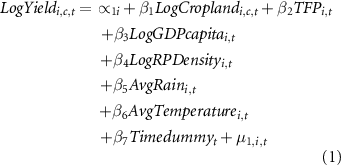
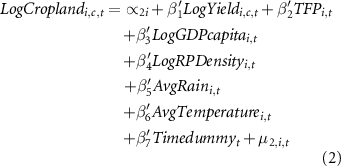
For all equations:

2.4.2. Short-run model specifications
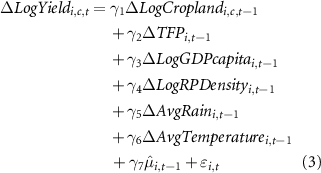
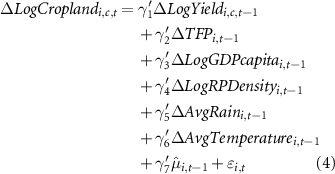
For all equations:

2.5. Long-run causality test
The presence of cointegration is sufficient to prove the existence of at least one non-spurious long-run causal relationship between the variables in at least one direction (Engle and Granger 1987), but it does not indicate the direction of the causality between the variables. This is because the long-run estimated coefficients represent the net effect of a system of relationships and cannot be directly interpreted as unilateral causal effects (Granger causality) but rather as a systemic causality. These long-run coefficients are unbiased but their standard errors are large and unreliable, and thus not robust for statistical inference (Stock 1987, Canning and Pedroni 2008). However, Canning and Pedroni 2008) proposed a way to test for the direction of long-run estimated coefficients in panel data avoiding this long-run inference problem, by carrying out standard hypothesis tests on the short-run coefficients estimated, which are superconsistent. We extended their two-variables design to a seven-variables model (equations (S1)–(S6)). This test identifies the sign of the ratio of error correction coefficients under a transformed specification, and thus allows us to identify the sign of the possible long-run causal effects between variables, noting that mutual causation can occur.
3. Results
3.1. Panel unit root tests and cointegration
For all crops aggregated, the statistical properties of most variables and income groups varied through time, as indicated by the results of our Fisher unit root tests (table S4). The test indicated stationarity in at least one panel of the yield, temperature and rainfall data across all income groups, and rural population density in low-income countries. Yet, visual inspection of these data showed temporal trends in most variables, indicating that most panels were non-stationary (figures S1–S6). The panel cointegration test results for the aggregated analysis indicated that the variables in our long-run equations were panel cointegrated in low and middle-income countries and thus showed a long-run equilibrium relationship (table S5). In order to treat the different sub-groups with a consistent cointegration approach, we used the results of the Fisher unit root test for the variables that are not crop-specific and the visual inspection of the different yield and cropland variables, which are crop-specific (figures S7–S12). The error correction terms (ECT) were significant in most short-run equations, justifying the cointegration approach. For a few regressions which had non-significant ECTs, i.e. different groups of oil palm and soybean producers with cropland area as dependent variable, our results may be less reliable.
3.2. All crops, by income groups (figures 2, 3, tables S7, S9)
The coefficients of the long-run regressions are unbiased and thus can be interpreted for their respective samples, but the test for the sign of the causality was significant for only some of those long-run coefficients. TFP had a positive and strong impact on yields for middle and high-income countries in the long run and for middle-income countries in the short run (figure 2, table S7). Cropland area had a negative effect on yields over the long run within our sample, which covers most countries of the globe over a meaningful time period, but the causality test failed to show statistically significant result beyond the sample. For all countries together, TFP had a positive effect on yields and a negative one on GDP. Over the long run, TFP had a positive effect on cropland area for all countries together, and for low-income countries, TFP had a positive effect and rural population density a negative effect (figure 3, table S9).
Figure 2. Regression results for yields as dependent variable. Result are shown for only the main explanatory variables related to our hypotheses, results for additional control variables (temperature and rainfall) are in tables S7 and S8. For the long-run regressions, the results show the regression coefficient for the long-run sample, the direction of the long-run coefficient as statistically estimated using the modified test from (Canning and Pedroni 2008), either positive or negative, arbitrarily indicated as 1 or −1. For the short-run regressions, the coefficient and 95% confidence interval (1.96 × standard error) are shown.
Download figure:
Standard image High-resolution imageFigure 3. Regression results for Cropland as dependent variable. Result are shown for only the main explanatory variables related to our hypotheses, results for additional control variables (temperature and rainfall) are in tables S7 and S8. For the long-run regressions, the results show the regression coefficient for the long-run sample, the direction of the long-run coefficient as statistically estimated using the modified test from (Canning and Pedroni 2008), either positive or negative, arbitrarily indicated as 1 or −1. For the short-run regressions, the coefficient and 95% confidence interval (1.96 × standard error) are shown.
Download figure:
Standard image High-resolution imageAll short-run regressions confirmed a long-run equilibrium between the variables, with the variable 'residuals', corresponding to the ECT, being significant and between 0 and −1. Farmers adjusted yields towards the long-run equilibrium generally more rapidly than cropland area, as indicated by the higher ECTs for yield as dependent variable compared to cropland area. Cropland area had a negative effect on yields in high-income countries and positive effect for middle-income countries (figure 2, table S7). TFP had a positive impact in low, high-income countries and all countries together, while rural population density had a negative effect in middle-income countries and all countries together. For cropland area (figure 3, table S9), yield had a positive but weak impact in middle-income and all countries together. TFP also had a positive and stronger impact in low- and middle-income countries, as well as all countries together. Rural population density and GDP had positive impacts on cropland area in low, middle-income and all countries together, and low-income countries and all countries together, respectively.
3.3. Crop- and region-specific results on yields (figure 2, tables S7, S8)
Over the long run, cropland area had a negative effect on yields, and thus an induced intensification effect, only for wheat. Yet, supporting the induced intensification thesis, in the short run cropland area had a negative effect on yields for wheat and maize, as well as the three main cereals (wheat, rice and maize) together. The same effect occurred for oil palm in Africa, where this constitutes a main staple crop. Rural population density had a positive impact on yields for several crops, i.e. soybean over the long run, and cocoa, coffee, oil palm in Africa, and soybean over the short run. Cocoa and coffee are labor-intensive crops, and may thus be particularly responsive to increases in labor availability. In contrast, several crops showed a positive effect of cropland area change on yields changes. In the long run, this was the case for cocoa, sugarcane, oil palm, rubber, high elasticity crops and flex crops. In the short run, this was the case for banana, soybean, and soybean in South American frontier countries and staple crops in sub-Saharan Africa.
3.4. Crop and region-specific results on cropland area (figure 3, tables S9, S10)
The intensification variables had a negative effect on cropland area in several cases, indicating a net land sparing effect. For yields, this was the case for rice and the group of the three main cereals in the long run, and for wheat in the short run. TFP had a negative effect for wheat and all countries together in the short and long run, as well as on rubber and the group of rubber and oil palm in Southeast Asian frontier countries, in the short run. In contrast, in other cases we observed a positive effect of intensification variables on cropland area, indicating a strong rebound effect. For yields, this was the case for rubber and flex crops in the long and short run, as well as for banana, cocoa, sugarcane, tropical fruits, high elasticity crops and soybean in South American frontiers in the short run. TFP had a positive long-run effect on harvested area for rice, maize, and all countries together, as well as a short-run effect for rice, banana, coffee, flex crops, staple crops in Sub-Saharan Africa, and oil palm in Africa. The positive effect of TFP increase on rice harvested area likely reflects increases in harvest frequency (e.g. double and sometimes triple cropping), rather than actual rice cropland expansion.
4. Discussion
The induced intensification theory supporting our Hypothesis 1 has a solid body of local evidence (Turner et al 1993, Turner and Ali 1996, Meyfroidt et al 2018). In our results, aggregating all crops, we found significant evidence for intensification induced by restrictions on cropland expansion, be they biophysical, technological, economic or institutional, only in the short run in high-income countries. Over the long run, though, our unbiased coefficient support the hypothesis for all our income groups for our sample of countries and years, which represent a crucial period of intensification such as through the Green Revolution (Stevenson et al 2013, Pellegrini and Fernández 2018). Increased population pressure caused cropland expansion in the short run in low and middle-income countries, but the opposite over the long run in low-income countries. This suggests that although the short-term response of increasing population pressure is generally to expand cropland, over the long-run induced intensification may reduce cropland expansion in low-income countries. We also found support for our Hypothesis 1 for staple crops such as cereals and oil palm in Africa, as well as for labor-intensive crops such as cocoa and coffee in the short run. Staple crops respond more directly to local demand than non-staples such as high value crops, and thus are more likely to see their production increasing through intensification if expansion is constrained.
In contrast, for several key commodity crops, cropland expansion induced an increase in yields over the long run (cocoa, sugarcane, oil palm, rubber, the group of high-elasticity crops and flex crops) or the short run (whole cropland area in middle-income countries, staple crops in SSA, soybean, banana). This could suggest the presence of agglomeration economies for these crops. When a country progressively expands the production of these crops, sometimes by specializing into them, producers may benefit from positive externalities such as increased knowledge transmission, skilled labor force, access to cheaper inputs, policy support, and others, which allow for yield improvements, as shown for soybean in Brazil (Garrett et al 2018, Richards 2018) and banana and pineapple in Costa Rica (Shaver et al 2015, Jadin et al 2016). Induced intensification and agglomeration economies are not mutually exclusive intensification pathways, but our results suggest that in some circumstances one dominates. Despite the lack of a strong induced intensification effect in our dataset for some key commodities, local studies provide evidence that restrictions on land use expansion can indeed induce intensification even for high-demand commodities, as shown in the Brazilian Amazon for soy and beef (Garrett et al 2018, Koch et al 2019).
We tested conditions under which intensification results in land sparing or rebound effect. Our Hypothesis 2 differentiated crops depending on their price-elasticity of demand. At the crop-specific level, we found evidence of land sparing over the long run for some staple cereals: With increasing yields for rice as well as for wheat, rice and maize together, and increasing TFP for wheat, and over the short term for wheat with TFP and yields. Among major crops, wheat and rice were shown to have lower growing-area elasticities to price than corn and soybeans (Iqbal and Babcock 2018). Land sparing with intensification of these crops is thus expected (Stevenson et al 2013, Phalan et al 2014). Yet, even for these crops, low absolute values in the short-term effects of yields increase indicates a partial rebound effect that reduces the land sparing.
Other subsets showed evidence of a rebound effect, mostly for low and middle-income countries. For all crops aggregated, yields had a rebound effect in middle-income countries over the short run. Many countries in this group, such as in Latin America, have export-oriented agriculture strongly engaged in global commodity markets, and land available for cropland expansion. Intensification increased their competitive advantage and supported increasing exports as well as growing domestic consumption with economic growth (Yao et al 2018). Crop-specific results showed a rebound effect of yields or TFP increases for several commodities with high price-elasticity of demand in which middle-income countries are dominant players, including bananas, coffee, sugarcane, rubber, flex crops, tropical fruits, palm oil in Africa, soybean in South American frontier countries, and the group of high-elasticity crops in tropical countries in the short run. Villoria (2019a) also found a rebound effect for countries with large commodity exporting sectors. Over the long run, the evidence for rebound effects is less strong, still existing for some crops such as rubber and flex crops, but disappearing for most other crops and, aggregating all crops, remaining mainly for intensification through technological progress, and only significant in low-income countries. Over the long run, and with economic development, rebound effects may decline as demand for many products saturate, or with stronger constraints on cropland expansion.
Regarding our Hypothesis 3, for low-income countries, TFP improvements induced a rebound-effect over both the long and the short run, corresponding to theoretical expectations for countries with poorly competitive agriculture, in which increasing TFP and competitiveness may decrease reliance on imports (Hertel et al 2014). This result was supported by the short-run rebound effect of yield increases on staple crops area in Sub-Saharan Africa. In contrast, the lack of effect of TFP on cropland area in high-income countries could be related to the much stronger constraints on land use expansion in these countries (Rudel et al 2009, Lambin and Meyfroidt 2011). There, technological progress mostly affects the efficiency of other inputs, in particular labor, rather than land. In the short run, neither the land sparing or rebound effect hypotheses were validated for high-income countries, indicating that other forces such as land use zoning and agricultural policies including subsidies may have stronger effects on cropland area changes. Increases in TFP had a positive impact on yields in many subsets, confirming the importance of continuing agricultural research as a strategy to increase yields (Coomes et al 2019).
Our analyses measure rebound-effect and land sparing as the effect of changes in one variable on another one—i.e. in relative terms—, but not directly indicating absolute cropland expansion or contraction. Our aggregated analyses summing all crops together allow investigating land sparing and rebound through substitution among crops, but do not account for substitution with other land uses (pasture, forestry). In our crop-specific analyses, the rebound and land sparing effect may represent effects on the total cropland area or substitution for one crop to another. Area expansion of a particular crop can come from land cultivated with other crops, from other land uses such as pastures, or from new conversion of land to agriculture. Thus, we cannot directly draw conclusions regarding net effects on deforestation or other natural habitat clearing. A rebound effect of cropland expansion occurring on pastures may still result in net contraction and land sparing on total agricultural lands, if crops produced intensively substitute for grass as animal feed (Yao et al 2018). Further, we only examine the rebound or land sparing within the region that experiences intensification, and thus cannot measure if land use changes in one country have land sparing or rebound effects elsewhere (Villoria 2019a, 2019b). Finally, the crop-specific analyses used harvested areas of these crops as a proxy for cropland area. Increasing harvest frequency was thus accounted for as area expansion, which likely blurred the results. This is particularly relevant for rice, the main crop for which several harvests per year are grown over significant areas (Portmann et al 2010), and to a lesser extent for soy which is increasingly double cropped (Spera et al 2014). Thereby we also could not adequately capture intensification occurring through shortening of fallows. We kept all variables together in one long-run relationship. Further works could also explore these questions by separating the long-run relationships among variables into several equations, with a different estimation of the ECM (Johansen 1988).
5. Conclusions
Human societies face trade-offs between production-oriented land uses and ecological outcomes (Phalan et al 2014, Phalan 2018, Meyfroidt et al 2018). Globalized food systems can contribute to a more efficient use of agriculture globally (Egli et al 2018, Heck et al 2018) but can also trigger increased consumption of natural resources (Bruckner et al 2012, Barger et al 2018, Tramberend et al 2019). Agricultural intensification is often seen as a key tool for sustainability, to lessen competition for productive land and mitigate associated trades-offs, but the dynamics and spillover effects of intensification remain insufficiently understood (Meyfroidt et al 2018).
Here, we developed and applied a methodological design that addresses key issues from previous statistical approaches, by analyzing different dimensions of intensification, and assessing long- and short-run mutual causal relationships between cropland area and intensity. We provided empirical evidence that the presence of a land-sparing versus rebound effect of intensification, as well as of induced intensification, varied across subsets of crops with distinct price elasticity of demand and labor intensity, and across regions with different conditions in terms of demand elasticity, constraints on cropland expansion, competitiveness and openness to markets. Our results support the induced intensification hypothesis for low-income countries over the long run to some extent, as well as for staple crops and oil palm in Sub-Saharan Africa, and labor-intensive crops such as cocoa and coffee in the short run. Intensification resulted in a rebound effect over the short run in low and middle-income countries, the latter including many key agricultural producers with strong competitiveness in global agricultural commodity markets, and land available for cropland expansion. This rebound effect manifested over the short run for several commodities with high price-elasticity of demand, including bananas, sugarcane, rubber, flex crops, tropical fruits, palm oil in Africa and soybean in Latin America frontier countries. Over the long run, 'backfire' rebound effects remained for some key high-elasticity commodities such as flex crops and rubber for their main producer countries, and soybean within our sample. Intensification of staple cereals such as wheat and rice, as well as total cropland area in middle-income countries, resulted in significant land sparing. Lastly, intensification driven by technological progress was generally more likely to result in a rebound effect than intensification due to yields increases driven by increased inputs use.
Our approach allows distinguishing short-term from long-term effects, which is key as crucial socio-environmental impacts occur when gross natural habitat conversion occurs. These insights can contribute to improve land-use policies targeted to specific contexts and crops, confirming that apart for staple crops over the long run, intensification is unlikely to result in actual land sparing for nature unless accompanied by appropriate policies and other interventions to control and orient cropland expansion (Lambin et al 2014). Further analyses could replicate our study with distinct sets of crops, countries and control variables, as well as with subnational-level data, to test for additional conditions and further refine theories explored. Our study design, building on cointegration, error-correction models and tests for long-run causality direction could be used for addressing other complex long- and short-run causal dynamics in land and social-ecological systems.
Acknowledgments
The authors thank participants in the Land Use and Leakage workshop at the Robert Bosch Foundation in Berlin, November 9–10, 2017 for valuable comments during preliminary stages of this paper. This work has received support from the European Research Council (ERC) under the European Union's Horizon 2020 research and innovation programme (Grant agreement N° 677140 MIDLAND, https://erc-midland.earth). It also contributes to the Global Land Programme (https://glp.earth).
Data availability statement
The data that support the findings of this study will be openly available following a delay from publication using the following unique identifier https://doi.org/10.5061/dryad.9zw3r22b8.


